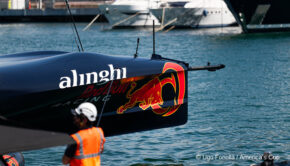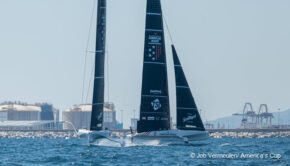Memories return for 12 Metre Worlds
Published on July 24th, 2023
The year 2023 marks exactly 40 years since the U.S. lost the America’s Cup to Australia on the world stage of Newport, RI. That moment in sports history might not have gotten the attention if not for two significant factors.
The Aussies successfully broke the longest winning streak in sporting history (132 years), and then the intrigue surrounding the moment when Australia unveiled its “secret weapon” winged keel on its winning 12 Metre Australia II (KA-6), skippered by John Bertrand, which prevailed four races to three over Liberty (US-40), skippered by Dennis Conner.
But there it was – on September 26, 1983 at Newport Offshore (now Club Wyndham Newport Onshore) – for millions across the globe to see by television and thousands in Newport to see in person: a bird-like appendage that contributed to a sporting upset bigger than any before, leaving 26-time (since 1851) America’s Cup Defender New York Yacht Club stunned and first-ever successful Challenger Royal Perth Yacht Club elated.
“What’s intriguing is that Challenge XII (KA-10) was built in 1982 for the 1983 Challenger Trials as a second boat for Australia (sailed by the Royal Victoria Yacht Club); it was a sister-ship to Australia II, except she had (and still has) a traditional keel instead of a winged keel,” said Jack LeFort (Winter Park, Fla./Jamestown, R.I.), who has owned Challenge XII for eight years.
LeFort will skipper Challenge XII in the upcoming 12 Metre World Championship on August 1-5 in Newport, RI. “No one on the outside knew what was giving Australia 2 an edge on speed, but Challenge XII was impressively fast, too.” (After losing in the Challenger quarterfinals, Challenge XII became the Trial horse for Australia II).
LeFort won the Modern Division at the 2019 12 Metre World Championship, also held in Newport, and says the competition this time around – among a total of ten historic 12 Metres (five in Modern and five in Traditional/Vintage Division) – will prove extraordinarily close on a world-class level.
“In the Modern Division, the team aboard Takashi Okura’s Freedom (US-30) (America’s Cup winner in 1980) has won the TP/52 Worlds twice, and the Enterprise (US-27) team, skippered by Peter Askew, is well known for its winning Wizard campaigns. As well, Courageous (US-26, Cup winner in 1974 and 1977) and Defender (US-33) have certainly proved themselves in recent regattas.”
“I was still in school in ’83 and was on the dock during the Trials in 1977 when Ted Turner and Gary Jobson rushed by with cameras following them,” said Courageous Skipper Dawn Riley, who would go on to sail in four America’s Cup races and two Whitbread Round the World races. “It made a big impression on a 13-year-old from Detroit!”
Riley will sail with a young and diverse crew from the Oakcliff Sailing Center she runs in Oyster Bay, NY. “No one other than me and one trimmer had ever stepped foot on a 12 Metre before this May,” said Riley. “Courageous seems to be a very solid boat, and when we can sail away from other boats, we are good.
“When we get close to them, we have some learning to do. Hydraulic headstays and runners, check stays, overlapping jibs, and dip pole jibes are all new to most of our team.”
According to Robert Morton (Middletown, RI), skipper of American Eagle (US-21, above) in Traditional/Vintage Division, “Everyone has to figure out how to beat Columbia (US-16, Cup winner in 1958). She has a consistent record of winning each regatta, and although it is very close racing, she has a definite speed edge on the rest of the fleet.
“We feel that consistency is a key aspect of a long regatta like this, so our goal is to stay near the top in every race. We have not sailed against Onawa (US-6) very much, so she adds a new dimension to the racing during this series.”
Nefertiti (US-19) and Weatherly (US-17, Cup winner in 1962) are also sailing in Traditional/Vintage Division.
Morton fondly remembers the times when the America’s Cup had a national interest and Newport was the center of the sports world for that whole summer of 1983.
“I was there on the final day of the Cup in ‘83, and I will never forget the huge spectator fleet coming in past Castle Hill with all their running lights on because the days were shorter in September,” said Morton.
“The 12 Metres turned out to be excellent boats for match racing and virtually all the technical developments associated with gearing the boats up for the Cup trickled down to the average sailor and racer. Today, the America’s Cup is way too far from the experience of the average sailor, and those boats will never be around and sailing 40 years from now.”
Details: https://12mrworlds.com/category/2023-12mr-world-championship/
Source: MPI









 We’ll keep your information safe.
We’ll keep your information safe.